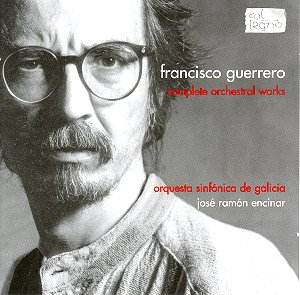At the time of his untimely death in October
1997, Francisco Guerrero left a quantitatively limited but substantial
output. This consists of several sizeable works such as his large-scale
cycle Zayin (1983 – 1997) (available on record but
which I have not heard so far) and some impressive orchestral
works recorded here. Incidentally, an early work Ecce Opus
of 1973 has not been included in the present otherwise complete
recording of Guerrero’s orchestral music.
Antar Atman of 1980 is thus the
earliest work here. Many of Guerrero’s hallmarks are already much
in evidence, foremost among them, an almost unstoppable energy
irresistibly pushing the music forward. This is probably one of
the most striking characteristics of his music. Complexity is
another prominent component, though the composer subtly argued
that his music is not complicated. He often compared his
music to a tree or a wave, i.e. to complex entities that may nevertheless
easily perceived as a whole. As soon as details obscure the perception
of the form, complication sets in. True to say that Guerrero’s
music is complex, intricately worked-out, but it retains a clear
sense of form (even if no traditional form) and of direction.
Antar Atman is, needless to say, quite complex,
even at times extravagantly so, but never of the expense of expression
which remains central to the composer’s concerns. In many respects,
albeit superficially, his music is rather similar to Ligeti’s
in its reliance of what may be referred to as micro-polyphony
and to Xenakis’s in its massive energy. Guerrero’s music often
suggests intractable, rugged landscapes in quite vivid orchestral
terms, though it is never programmatic. The very end of this powerful
piece is quite characteristic of Guerrero’s music: a long-held
high note bluntly answered by some grumble from the double basses.
Ariadna, completed in 1984, is
scored for twenty strings (ten violins, five violas and five cellos)
laid-out in twenty real parts and using many playing techniques.
The music spirals endlessly, thus creating a fascinating network
of intermingling lines without ever losing sight of the red thread
running throughout the piece. Guerrero’s liking for string sounds
and mastery in writing for them is quite impressive indeed.
The opening section of Sáhara
of 1991 is again for strings alone. They hold a long unison E
flat, without sounding static. Variety is achieved by the strings’
staggered entries such suggesting a formidable activity beneath
the apparently static surface. Tension increases considerably
till halfway through the piece, at which point the woodwinds and
brass enter in often massive chords, again evoking some sun-drenched,
inhuman landscapes.
Oleada, scored for full string
orchestra, is quite similar to Ariadna, though much
use is made of the full tonal potential of the strings, with great
emphasis on extreme contrasts. As implied by the title (derived
from the Spanish word Ola meaning Wave), the music
unfolds in massive waves of sounds often opposing extreme registers
(another characteristic of his music indeed).
To commemorate the fiftieth anniversary of de
Falla’s death, the Junta de Andalucia (Andalusian Regional Government)
commissioned works from four Andalusian composers of different
generations: Manuel Castillo, Rafael Diáz, José
García Román and Francisco Guerrero. The latter
responded with Coma Berenices completed in 1996
and eventually his last completed work. It was first performed
posthumously in 1998 by the Orquesta de Cordoba conducted by Leo
Brouwer. (This performance, as well as that of two of the other
commissioned pieces, i.e. Castillo’s Sinfonietta Homenaje
and Diaz’s magnificent Concierto Andaluz, is available
on ALMAVIVA DS 019.) The title Berenice’s Hair is the name
of a constellation, though again the piece does not aim at any
descriptive programme. The music, full of arresting orchestral
touches and displaying the composer’s total mastery and assurance
in handling large orchestral forces, nevertheless, conjures up
remote, mysterious outer space as well as the tremendous energy
unleashed by exploding novas (two mighty percussion cadenzas).
If there ever was a Music of the Spheres, this is it.
At the time of his death, Guerrero was also busy
with another important project which was left unfinished, an orchestration
of Albeniz’s Iberia. He also repeatedly (and half-jokingly)
mentioned that his music was to change drastically as soon as
the orchestration would have been completed, without giving any
real hint of the direction his music was to take.
The Orquesta Sínfonica de Galicia may
not be a world-class orchestra, but they play this difficult,
demanding music with much aplomb, assurance and – most importantly
– with all their hearts. Encinar contrives superb, vital performances,
beautifully caught by the recording team.
Complex, demanding, often gripping, powerfully
expressive and ultimately quite rewarding, such is Francisco Guerrero’s
music. I can not but recommend this release most heartily. This
is my record of the month.
Hubert Culot
